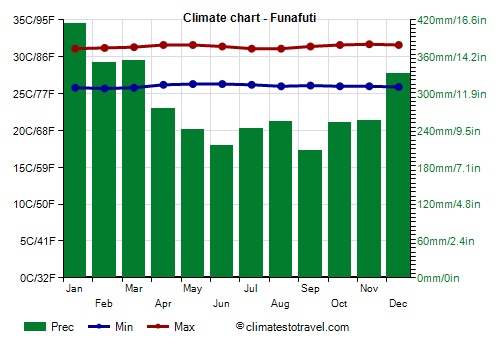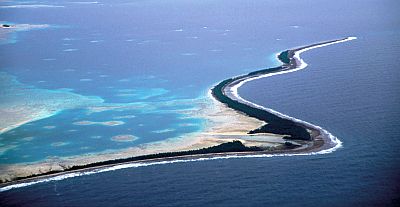Select units of measurement for the temperature and rainfall tables (metric or imperial).
Average weather, temperature, rainfall, sunshine
Tuvalu (formerly Ellice Islands), an archipelago located in the Pacific Ocean to the south of the Equator, has an
equatorial climate, ie hot, humid and rainy throughout the year. The rains, occurring in the form of downpours of thunderstorms, can be intense, but usually do not last long, and do not greatly reduce the hours of sunshine.
Temperatures are very stable, around 25/26 °C (77/79 °F) at night and 31/32 °C (88/90 °F) during the day. The trade winds blow all year round, but especially in the period from April to October, tempering a little the heat. At night it never gets cold, and the temperature never drops below 20 °C (68 °F). On warmer days, temperatures rarely exceed 34 °C (93 °F).
Rainfall is abundant, ranging from 2,500 millimeters (98 inches) per year in the northern atolls (see Nanumea) to 3,000/3,500 mm (118/138 in) in the central-southern ones (see Funafuti, Niukalita).
The climate in detail
Temperature and rain
Funafuti

In the capital,
Funafuti, located in the south-central part, at 8 degrees south latitude, the average temperature varies between 28.5 °C (83.5 °F) in January and February and 29 °C (84 °F) in May.
In Funafuti, 3,400 mm (134 in) of rain fall per year, with a peak between December and March, when rainfall is equal to or greater than 300 mm (12 in) per month, and a minimum (very relative...) between May and November, when it drops below 260 mm (10.2 in) per month.
In 2011, a year of La Niña, only 1,700 mm (67 in) of rain fell, and there was a long period with little rain, from February to October.
The amount of sunshine at Tuvalu is decent but not exceptional, as clouds that can give rise to rain showers are frequent, but as mentioned, they do not last long. In Funafuti, there are 2,350 hours of sunshine per year.

Sea temperature
The
sea in Tuvalu is warm enough to swim in all year round, in fact the water temperature ranges from 29 °C to 30 °C (84 to 86 °F).
Tropical cyclones
Tuvalu is affected by the
tropical cyclones of the South Pacific. Cyclones are usually formed from November to mid-May, though they are most likely from late December to early April. Sometimes, however, they have affected the archipelago outside of this period, as happened with Bebe in late October 1972 and Keli in June 1997 (both El Niño periods, in which cyclones are more likely).
Being not far from the Equator, the islands are generally affected by cyclones
at the beginning of their formation, but considering that Tuvalu is one of the flattest countries in the world, it may be affected by flooding and storm surges, even when cyclones are not are very strong or if they pass at a certain distance.
The northernmost islands (Nanumea, Niutao, Nanumanga), closer to the Equator, are located at the edge of the area, where cyclones are more rare, while the most affected islands are the southernmost ones (Nukulaelae and Niulakita).
When to go
The best time to travel to Tuvalu is from
mid-May to late October, since it is the (relatively) least rainy period, and out of the cyclone season.
However, since cyclones have sometimes passed outside of the canonical period, to be on the safe side, you can choose the period from July to mid-October.
What to pack
All year round, pack
tropics-friendly, loose-fitting clothing, a sun hat, a scarf for the breeze, a light sweatshirt for the evening, and a light raincoat or umbrella.
Climate data - Tuvalu
| Funafuti |
|---|
|
| Jan | Feb | Mar | Apr | May | Jun | Jul | Aug | Sep | Oct | Nov | Dec |
|---|
| Min temp. | 26 | 26 | 26 | 26 | 26 | 26 | 26 | 26 | 26 | 26 | 26 | 26 |
|---|
| Max temp. | 31 | 31 | 31 | 32 | 32 | 31 | 31 | 31 | 31 | 32 | 32 | 32 |
|---|
| Precip. | 415 | 350 | 355 | 275 | 240 | 215 | 245 | 255 | 205 | 255 | 255 | 335 |
|---|
| Prec. days | 19 | 18 | 19 | 17 | 17 | 17 | 18 | 18 | 16 | 16 | 16 | 19 |
|---|
|
|
| Sun hours | 6 | 6 | 6 | 7 | 6 | 7 | 6 | 7 | 7 | 8 | 6 | 6 |
|---|
| Sea temp | 30 | 30 | 30 | 30 | 30 | 29 | 29 | 29 | 29 | 30 | 30 | 30 |
|---|
| Nanumea |
|---|
|
| Jan | Feb | Mar | Apr | May | Jun | Jul | Aug | Sep | Oct | Nov | Dec |
|---|
| Min temp. | 26 | 26 | 26 | 26 | 26 | 26 | 26 | 26 | 26 | 26 | 26 | 26 |
|---|
| Max temp. | 31 | 31 | 31 | 31 | 31 | 31 | 31 | 31 | 31 | 32 | 32 | 32 |
|---|
| Precip. | 290 | 280 | 275 | 240 | 210 | 195 | 170 | 200 | 150 | 155 | 160 | 260 |
|---|
| Prec. days | 15 | 14 | 16 | 16 | 16 | 15 | 15 | 15 | 12 | 13 | 11 | 14 |
|---|
|
|
|
|
| Niukalita |
|---|
|
| Jan | Feb | Mar | Apr | May | Jun | Jul | Aug | Sep | Oct | Nov | Dec |
|---|
| Min temp. | 26 | 25 | 25 | 26 | 26 | 25 | 25 | 25 | 25 | 25 | 25 | 26 |
|---|
| Max temp. | 31 | 31 | 31 | 32 | 31 | 31 | 31 | 31 | 31 | 31 | 31 | 32 |
|---|
| Precip. | 370 | 330 | 340 | 195 | 230 | 240 | 225 | 220 | 180 | 265 | 265 | 270 |
|---|
| Prec. days | 18 | 17 | 17 | 15 | 16 | 16 | 15 | 15 | 14 | 16 | 16 | 16 |
|---|
|
|
|
|